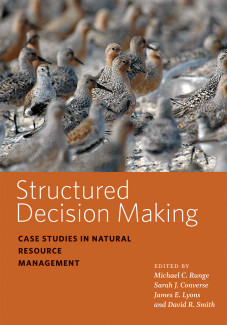
Johns Hopkins UniversityEst. 1876
America’s First Research University
Structured Decision Making: Case Studies in Natural Resource Management

Management of our natural resources requires difficult decisions. We balance tradeoffs between water for crops, fish, and people. We choose protected areas when we’re uncertain about the future effects of climate change. We decide how much to invest in the study of potential zoonotic diseases. Each of these decisions has significant consequences for ecosystems, species, and people.
To make it most likely that we’ll achieve the outcomes we want from our decisions, it makes sense to use the best approaches to decision making. Decision analysis, also known as structured decision making, is designed to help decision makers make difficult choices more effectively. Structured decision making helps decision makers develop a cognitive “map” of their difficult decisions and gives them the tools they need to deal with challenges like tradeoffs, risk, and uncertainty.

Over the last 15 years, the four of us—all ecologists and decision analysts with the U.S. Geological Survey—have worked with other natural resource scientists and managers from around the world to develop the theory and practice of structured decision making for natural resource management. Our new book, Structured Decision Making: Case Studies in Natural Resource Management, synthesizes these efforts. We’ve learned several lessons along the way, including: that understanding a decision problem comes before finding an effective solution; that solving a decision problem cannot rely on science alone, although science is a crucial piece of the solution; and that thinking creatively about things we can do is often more important than listing things we can learn.
Every natural resource management problem seems unique at first, complicated in its own special way. But over the last 15 years, as we have worked on difficult decisions with natural resource managers around the world, we’ve seen a few types of decisions come up repeatedly. A decision type, we realized, is determined by what makes a decision difficult. Some decisions are difficult because the structure of the decision is hidden. Others require tradeoffs among things we care about. For other decisions, allocating limited resources or dealing with risk pose the challenge. Many decisions are complicated because uncertainty obscures the best path to take. And finally, difficulty sometimes arises when we need to anticipate how a decision today influences future decisions. While many natural resource decisions are simply hard, recognizing the type of decision can help identify the right tools to solve the problem. We organized the book around six decision types and wrote introductory chapters to lay out the tools appropriate for each type. Case study chapters follow the introductory chapters to illustrate applications on a variety of different decisions.
Michael C. Runge is a research ecologist at the United States Geological Survey (USGS) Patuxent Wildlife Research Center. Sarah J. Converse is the unit leader of the USGS Washington Cooperative Fish and Wildlife Research Unit and an associate professor at the University of Washington. James E. Lyons is a research ecologist at the USGS Patuxent Wildlife Research Center. David R. Smith is a research statistician at the USGS Leetown Science Center. Together, Runge, Converse, Lyons, and Smith are the editors of Structured Decision Making: Case Studies in Natural Resource Management.



